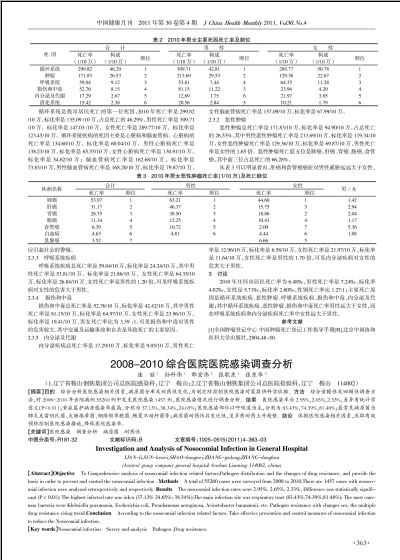2008-2010综合医院医院感染调查分析
 |
| 第1页 |
参见附件(3143KB,3页)。
【摘要】目的 综合分析医院感染相关因素,病原菌分布及耐药性变化,为制定防控制医院感染对策提供科学依据。方法 综合前瞻性及回顾性调查方法,对2008-2010年出院病例55260例中发生医院感染1457例,医院感染情况进行调查分析。结果 医院感染率为2.95%,2.65%,2.33%,差异有统计学意义(P<0.01);重症监护病房感染率最高,分别为37.13%,38.34%,24.65%;医院感染部位以呼吸道为主,分别为83.43%,74.39%,81.48%;最常见病原菌为肺炎克雷伯氏菌、大肠埃希菌、铜绿假单胞菌、鲍曼不动杆菌等;病原菌耐药性具变迁性,呈多药耐药上升趋势。结论 依据医院感染相关因素,采取有效预防控制医院感染措施,降低医院感染率。
【关键词】医院感染 调查分析 病原菌 耐药性
中图分类号:R181.32 文献标识码:B 文章编号:1005-0515(2011)4-363-03
Investigation and Analysis of Nosocomial Infection in General Hospital
LIAN-li,SUN-kewei,SHAO-hongwei,ZHANG-gedong,ZHANG-donghua
(Ansteel group company general hospital Anshan Liaoning 114002, china)
【Abstract】Objective To Comprehensive analysis of nosocomial infection related factors,Pathogen distribution and the changes of drug resistance, and provide the basis in order to prevent and control the nosocomial infection . Methods A total of 55260 cases were surveyed from 2008 to 2010,There are 1457 cases with nosocomial infection were analyzed retrospectively and respectively. Results The nosocomial infection rates were 2.95%, 2.65%, 2.33%, Difference was statistically significant (P < 0.01); The highest infected rate was inIcu (37.13% 24.65%; 38.34%);The main infection site was respiratory tract (83.43%,74.39%,81.48%); The most common bacteria were Klebsiella pneumonia, Escherichia coli, Pseudomonas aeruginosa, Acinetobacter baumannii, etc. Pathogen resistance with changes sex, the multiple drug resistance rising trend.Conclusion According to the nosocomial infection related factors, Take effective prevention and control measures of nosocomial infection to reduce the Nosocomial infection.
【Key words】Nosocomial infection Survey and analysis Pathogen ,Drug resistance.
医院感染时刻伴随医疗行为,医院感染监测是医疗安全的一道防线,笔者通过调查分析我院2008年至2010年医院感染情况,为防控医院感染提供科学依据。
1 资料与方法
1.1 资料来源 分析我院2008年1月-2010年12月出院患者55260例,发生医院感染1457例。
1.2 分析方法 采用前瞻性及回顾性调查方法对医院感染病例进行综合性分析。
1.3 诊断标准 依据卫生部2001年《医院感染诊断标准》。
1.4 统计分析 相关数据经差别显著性检验,P<0.01差异有统计学意义。
2 结果
2.1 医院感染率及例次率呈逐年下降 2008-2010年医院感染率为2.95%,2.65%,2.33%,经X2检验,差异有统计学意义(X2=13.34,P<0.01);医院感染例次率为3.31%,2.94%,2.56%,经X2检验,差异有统计学意义(X2=31.22,P<0.01)。见表1
表1 2008年-2010年医院感染率(%)
2.2 科室医院感染情况 临床科室医院感染率差异很大,与科室特点有关,医院感染率前三位:重症监护病房,干老年病房,神经治疗中心。见表2
2.3 医院感染部位构成比 医院感染部位前三位为:呼吸道感染(74.39%~83.43%),泌尿道感染(6.73%~12.57%),胃肠道感染(3.55%~7.24%)。见表3
2.4 全院病原菌构成比 最常见病原菌为肺炎克雷伯氏菌、大肠埃希菌、铜绿假单胞菌、鲍曼不动杆菌肺炎。见表4
3 讨论
3.1 通过对医院感染信息监测及综合分析、采取有效措防控施及反馈持续改进的途径,以提高医院感染管理质量,降低医院感染率,达到保障医疗安全、提高医疗质量的目的。我院3年的医院感染发病率呈持续下降,2 ......
您现在查看是摘要介绍页,详见PDF附件(3143KB,3页)。